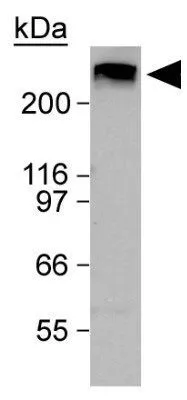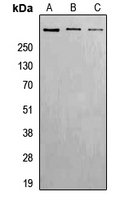![ELISA analysis of antigen using GTX60404 ATM antibody [5C5]. Red : Control antigen 100ng Purple : Antigen 10ng Green : Antigen 50ng Blue : Antigen 100ng ELISA analysis of antigen using GTX60404 ATM antibody [5C5]. Red : Control antigen 100ng Purple : Antigen 10ng Green : Antigen 50ng Blue : Antigen 100ng](https://www.genetex.com/upload/website/prouct_img/normal/GTX60404/GTX60404_20170912_ELISA_w_23061123_899.webp)
ELISA analysis of antigen using GTX60404 ATM antibody [5C5]. Red : Control antigen 100ng Purple : Antigen 10ng Green : Antigen 50ng Blue : Antigen 100ng
ATM antibody [5C5]
GTX60404
ApplicationsWestern Blot, ELISA
Product group Antibodies
TargetATM
Overview
- SupplierGeneTex
- Product NameATM antibody [5C5]
- Delivery Days Customer9
- Application Supplier NoteWB: 1/500 - 1/2000. ELISA: 1/10000. *Optimal dilutions/concentrations should be determined by the researcher.Not tested in other applications.
- ApplicationsWestern Blot, ELISA
- CertificationResearch Use Only
- ClonalityMonoclonal
- Clone ID5C5
- ConjugateUnconjugated
- Gene ID472
- Target nameATM
- Target descriptionATM serine/threonine kinase
- Target synonymsAT1, ATA, ATC, ATD, ATDC, ATE, TEL1, TELO1, serine-protein kinase ATM, A-T mutated, AT mutated, TEL1, telomere maintenance 1, homolog, ataxia telangiectasia mutated, serine/threonine kinase ATM
- HostMouse
- IsotypeIgG1
- Protein IDQ13315
- Protein NameSerine-protein kinase ATM
- Scientific DescriptionThe protein encoded by this gene belongs to the PI3/PI4-kinase family. This protein is an important cell cycle checkpoint kinase that phosphorylates; thus, it functions as a regulator of a wide variety of downstream proteins, including tumor suppressor proteins p53 and BRCA1, checkpoint kinase CHK2, checkpoint proteins RAD17 and RAD9, and DNA repair protein NBS1. This protein and the closely related kinase ATR are thought to be master controllers of cell cycle checkpoint signaling pathways that are required for cell response to DNA damage and for genome stability. Mutations in this gene are associated with ataxia telangiectasia, an autosomal recessive disorder. [provided by RefSeq, Aug 2010]
- Storage Instruction-20°C or -80°C,2°C to 8°C
- UNSPSC12352203

![WB analysis of HEK293 (1) and ATM(AA: 2705-2820)-hIgGFc transfected HEK293 (2) cell lysate using GTX60404 ATM antibody [5C5]. WB analysis of HEK293 (1) and ATM(AA: 2705-2820)-hIgGFc transfected HEK293 (2) cell lysate using GTX60404 ATM antibody [5C5].](https://www.genetex.com/upload/website/prouct_img/normal/GTX60404/GTX60404_20170912_WB_w_23061123_314.webp)
![WB analysis of 40 ug of lysate from HeLa cells untreated (Lane 1), treated with 10uM Camptothecin for 4h (Lane 2) or 12h (Lane 3) using GTX15666 ATM (phospho Ser1981) antibody [10H11]. Dilution : 1:1000](https://www.genetex.com/upload/website/prouct_img/normal/GTX15666/GTX15666_1510_WB_w_23060620_543.webp)

![WB analysis of irradiate or peroxidase treated human fibroblast lysate using GTX30636 ATM (phospho Ser1981) antibody [10H11.E12].](https://www.genetex.com/upload/website/prouct_img/normal/GTX30636/GTX30636_1445_WB_w_23060722_646.webp)
